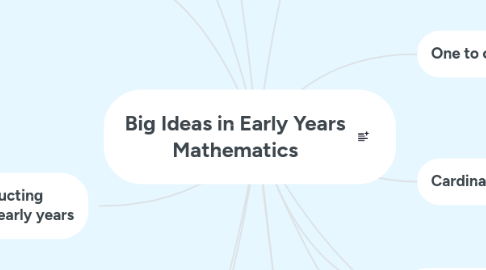Big Ideas in Early Years Mathematics
by Holly Shippen

1. Hierarchical inclusion
1.1. Piaget 1965; Kamii 1985
1.2. Numbers build on one another and nest within one another in exactly one at a time.
2. Compensation
3. Part/ Whole relationships
4. Strategies for constructing number sense in the early years
4.1. Games
4.1.1. Board games
4.1.2. Dice games
4.1.3. Card games
4.2. Routine experiences
4.2.1. Lining up
4.2.2. Getting food
4.2.3. Taking the register
4.2.4. Cooking and baking
4.2.5. Playing outdoors
4.3. Community experiences
4.3.1. Food shopping
4.3.2. People watching
5. Stable order
5.1. Fixed and unmoving numbers
6. Order irrelevance
7. Movement is magnitude
8. One to one correspondence
8.1. Meaning, for example, that if you have four cats and each eats from its own bowls, you would also have four bowls.
9. Cardinality
9.1. This is the idea that numbers are representative of an amount, and the bigger a number the more of that ‘item’ you have.
9.2. This quantity is the same no matter how it is laid out or organised.
10. Counting on
10.1. 11/21 circle game
11. Cardinal to count
12. Ordinal for position
12.1. First
12.2. Second
13. Nominal for name
13.1. Bus
13.2. Phone
14. Abstraction
14.1. Spoken words
14.2. Jumps
14.3. Music
14.4. Rhythm
14.5. Sleeps


